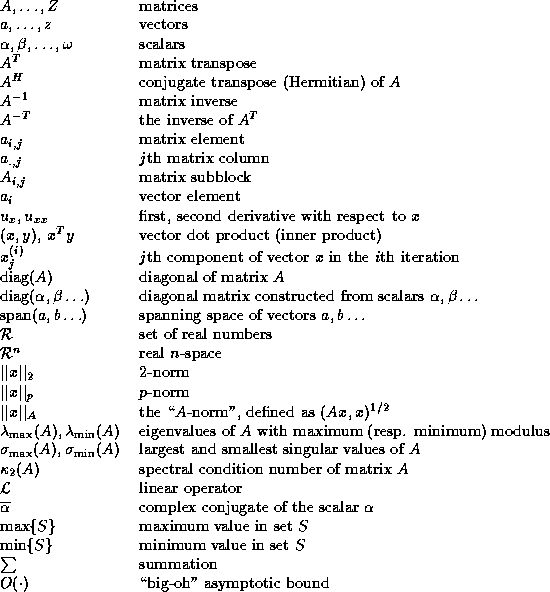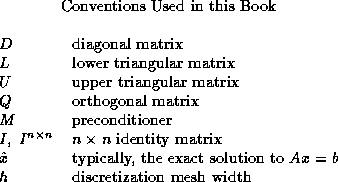We have divided this book into five main chapters.
Chapter ![]() gives the motivation for this book
and the use of templates.
gives the motivation for this book
and the use of templates.
Chapter ![]() describes
stationary and nonstationary iterative methods. In
this chapter we present both historical development and
state-of-the-art methods for solving some of the most challenging
computational problems facing researchers.
describes
stationary and nonstationary iterative methods. In
this chapter we present both historical development and
state-of-the-art methods for solving some of the most challenging
computational problems facing researchers.
Chapter ![]() focuses on preconditioners. Many
iterative methods depend in part on preconditioners to improve
performance and ensure fast convergence.
focuses on preconditioners. Many
iterative methods depend in part on preconditioners to improve
performance and ensure fast convergence.
Chapter ![]() provides a glimpse of issues related
to the use of iterative methods.
This chapter, like the preceding, is
especially recommended for the experienced user who wishes to have
further guidelines for tailoring a specific code to a particular
machine.
It includes information on complex systems, stopping criteria,
data storage formats, and parallelism.
provides a glimpse of issues related
to the use of iterative methods.
This chapter, like the preceding, is
especially recommended for the experienced user who wishes to have
further guidelines for tailoring a specific code to a particular
machine.
It includes information on complex systems, stopping criteria,
data storage formats, and parallelism.
Chapter ![]() includes overviews of related
topics such as
the close connection between the Lanczos algorithm and the Conjugate
Gradient algorithm, block iterative methods,
red/black orderings,
domain decomposition methods,
multigrid-like methods, and
row-projection schemes.
includes overviews of related
topics such as
the close connection between the Lanczos algorithm and the Conjugate
Gradient algorithm, block iterative methods,
red/black orderings,
domain decomposition methods,
multigrid-like methods, and
row-projection schemes.
The Appendices contain information on how the templates and BLAS software can be obtained. A glossary of important terms used in the book is also provided.
The field of iterative methods for solving systems of linear equations is in constant flux, with new methods and approaches continually being created, modified, tuned, and some eventually discarded. We expect the material in this book to undergo changes from time to time as some of these new approaches mature and become the state-of-the-art. Therefore, we plan to update the material included in this book periodically for future editions. We welcome your comments and criticisms of this work to help us in that updating process. Please send your comments and questions by email to templates@cs.utk.edu.

